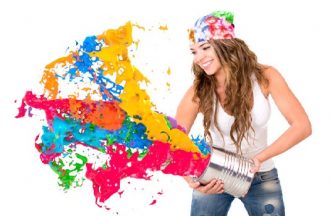By Larry Dignan
Guest writer for Wake Up World
Despite being the most necessary organ in the body, scientists continually find themselves astounded by new and exciting facts about the brain’s intriguing, mysterious complexities.
Creativity in particular oftentimes piques their curiosity because it both keeps humanity moving forward and stands as notoriously difficult to fully define. Although much of its realities remain shrouded, researchers do know of a few proven strategies for nursing it.
When inspiration stalls, try applying some of these methods and see which one works best.
Psychological distance
When puzzling over a creative quandary, take a step back and create some physical and psychological space. Indiana University at Bloomington students in Greece and their own state alike contributed to Lile Jia, Edward R. Hirt, and Samuel C. Karpen’s study, which revealed that absence makes the head and heart grow more innovative. The more distance, the more the brain processes a problem in the abstract – a necessary component of creative thinking.
[pro_ad_display_adzone id=”110028″]
Embrace the metaphors
Funny enough, “putting two and two together” and “thinking outside the box” completely work on a not-at-all-figurative level. An article in Psychological Science explored this phenomenon and discovered that acting out the metaphors in real life bolstered creativity, though it didn’t improve overall performance. Do keep in mind, though, that researchers took measures using the standardized RAT.
Attain REM sleep
Dream a little dream if those creative sparks need more than just a bit of flint to get going, because hitting a REM state remains one of the best things anyone can do for their projects. One doesn’t need science to see this trope in action, however, as notable names like Salvador Dali, Mary Shelley, and Michael Stipe all cited their unconscious nocturnal adventures as the starting point for some of their most popular works. Several University of California researchers went ahead and looked for the psychology and biology behind it anyway, and found that dreaming nurtures new information syntheses that don’t occur in waking life.
Channeling that inner Hulk
Multiple studies by University of Amsterdam and University of Gronigen noted that a little bit of anger promotes innovative thinking, but it comes with a temporal price tag. Negative emotions allowed to simmer prove less conducive to pumping out excellent projects than their fresher predecessors. So make sure to (peacefully!) lay that rage out quickly before the creative component starts dissolving; it’ll definitely prove more cathartic.
Moderate alcohol consumption
Psychosomatically, anyways, according to an Addictive Behavior article on the frequently disputed link between alcohol and creative output. In actuality, performance improved little, if at all, in the test groups given a tipple – though they ranked themselves higher in terms of perceived performance. While the controversy continues splitting scientists, avoiding blackout drunkenness will certainly keep a brain healthy for everything that comes its way.
Listen to music
Scientific and engineering unfortunately receive little credit as truly creative pursuits, but they certainly are – and they just happen to benefit from the same stimuli as their painterly peers. Next time a theorem or AUTOCAD assignment starts drying up the well, as it were, take the advice of Georgia Tech’s Parag Chordia and indulge in something a little melodic. Future studies will delve into what specific musical styles impact the mind in what specific way, if any.
Blue, da ba di da ba dai
Come to find out, blue achieves far more than just calming down anxious patients at the dentist’s office. Tobias Funke was really onto something when he painted his entire body the venerable color, because come to find out it can actually bolster one’s creative spirit! Red also benefits cognitive function as well, though it improves the ability to process details – a necessary component of innovation.
Intentional culture shock
Blend “thinking outside the box” with “psychological” distance and dive headfirst (with proper research and resources, of course!) into one highly valuable strategy for nurturing creative thought. In their Personality and Social Psychology Bulletin paper, Hajo Adam, Adam Galinsky, and William Maddux extol the potential of spending a stint abroad. Even the tiniest of cultural differences piques the ol’ grey mass and challenges it to consider the world in bright new ways.
Interacting with technology
Most technological interfaces with a high degree of interactivity, such as those intended for design and art, engage the brain in ways traditional media never could. In addition to this additional stimulation, the University of Gothenburg study also believed the faster, easier programs also cut down prep time, meaning more energy pours into the actual creation process. Not to mention quicker edits and brand new techniques otherwise impossible with the standard pens, pencils, and paints.
Extended or flexible deadlines
Harvard’s Edsel Bryant Ford Professor of Business Administration Teresa Amabile knows many people claim to create best when suffering beneath looming deadlines, but her research shows otherwise. For more than a decade, she’s studied interplay between creativity and time pressure and discovered the latter typically (though not always) holds negative sway over the former. Creativity thrives more in environments where deadlines wrap around minds, not the other way around.
Avoid brainstorming
And, if brainstorming is necessary, try to do it solo instead of in a group, as the latter tends to accomplish the exact opposite of the true intent. When multiple people participate, the dynamic usually begins obsessing over one particular idea, which discourages others from contributing to their fullest potential. These findings come courtesy of a collaboration between Texas A&M and University of Texas at Arlington researchers.
[pro_ad_display_adzone id=”110030″]
Rewards…kind of
Children do exhibit heightened creativity when presented with a reward for their efforts, but only if the association between task and receipt has already been pre-established. Interestingly enough, studies conflict over whether or not the findings extend into adulthood, as many believe a job well done elicits far more satisfaction than any award or honor. When it comes to the kiddies, though, consider training them with this tactic to challenge their growing minds.
Multilingualism
Traveling gets expensive, and for the cash-strapped hoping to score a little perspective without forking over the dough should attempt learning a brand new language. A study conducted by the European Commission revealed that multilingual individuals enjoyed heightened creativity and innovations thanks to overall improved cognitive and problem-solving skills. So investing in those Rosetta Stone programs might very well bolster one’s own all-around mental performance.
Exercise
Aerobic workouts are some of the simplest strategies for making the brain a very happy organ indeed. Not only will they generally lead to a more satisfied, positive mood, but it can lead to greater creativity in kind. Rather than pausing for nap time and struggling to sleep when sleep just won’t come, try 15 minutes of heart-healthy exercise instead.
Transcendental meditation
Transcendental meditation works for the spiritually-inclined, skeptics, and nonbelievers alike – no dogma necessary. Cornell researchers published a curious article showcasing how practitioners, over the span of five months, watched a marked improvement in their creative skills. However, this did not apply to verbal acumen, though they were more mentally flexible and figurative.
Play video games
In a finding sure to delight video game enthusiasts, this ubiquitous pastime does benefit players beyond heightened eye-hand coordination skills. Much like other interactive technologies, video games — played in moderation — encourage innovative thinking and problem solving through puzzles and other challenges. The most creative individuals also ended up the most negative (which shouldn’t be a surprise considering the anger link) and more lethargic.
Sarcasm
Similar to anger, sarcasm and its ilk also influence devotees and their peers to start approaching tasks with a broader imagination and innovation. Interestingly enough, though, while feeling anger bolsters the brain, witnessing it held the exact opposite effect. These findings come courtesy of Ella Miron-Spektor’s team, who published them in Journal of Applied Psychology.
Exposure to absurdity
Pick up absurdist – or at least whimsical – literature during creative dry periods for a generous dose of inspiration. A collaboration between University of California, Santa Barbara’s Travis Proulx and University of British Columbia’s Steven J. Heine exposed participants to Franz Kafka’s short stories, discovering that the writer’s techniques promoted pattern recognition and novel thinking. Both of these abilities prove necessary when whipping up the most creative projects possible; plus, Kafka also happens to totally rule, so everyone wins.
Play
Kids and adults alike benefit from playtime, giving parents, guardians, and teachers a perfect strategy for kick starting their own stalled pursuits. Enjoyable recreation relaxes as well as stimulates, easing the mind into a project instead of falling headfirst. Besides, pretty much everyone loves getting out and having fun, unlike some of the other suggestions here.
About the author:
Larry Dignan is a freelance writer and blogger who regularly writes for Onlinecollegecourses.com.
[pro_ad_display_adzone id=”110027″]







